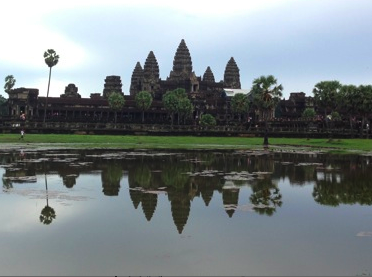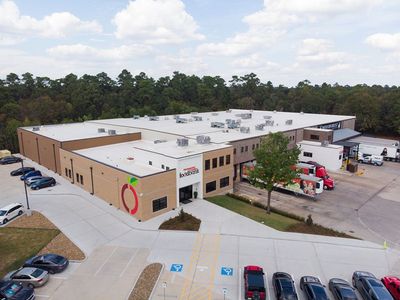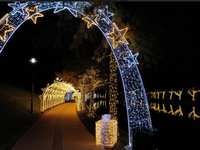- Sections :
- Crime & Public Safety
- Restaurants & Food
- Sports
- More
Categories
Cambodia: Kingdom of Wonder

THE WOODLANDS, Texas -- It’s summertime, and many of us are fleeing to the shores and cities in order to cool off and escape from the daily grind. But you need not limit the scope of your destination to American beaches or European castles. The Far East beckons! As I discovered, Southeast Asia is a playground for those who crave bargains and thrive on adventure. Yes, it’s sweaty, and, yes, it’s unfamiliar—but isn’t travel about trying new things? Say goodbye to your comfort zone and venture with me to Vietnam, Cambodia and Thailand. You won’t regret it!
A short plane ride will take you from Ho Chi Minh City to Siem Reap, Cambodia, the so-called “Kingdom of Wonder.” The title is a scheme dreamt up by the Ministry of Tourism, but Cambodia lives up to its name. Believe it or not, my two day Cambodian rest stop proved to be the most memorable and resonant of my whirlwind Southeast Asian sojourn.
So what is there to do in Cambodia? Well, first you should block off a whole day and get yourself over to Angkor Wat. It’s a sprawling complex of ruins from the Khmer Empire (kind of the Aztec’s Asian counterpart) that will knock your socks off. One ticket will buy you entrance to not only the incomparable Angkor Wat, but also Angkor Thom, Ta Prohm (the temple from "Lara Croft: Tomb Raider") and various other ancient goodies.
Remarkably well preserved, intimidating in scale, these Hindu/Buddhist temples make you wonder how 12th century architects completed them without the help of aliens. For example, standing at the center of Angkor Wat holding a compass, you can verify its orientation at exactly zero degrees north. A modern architect would have trouble aligning a structure perfectly with the four cardinal directions. Pretty neat stuff, huh? Otherwise the complex is riddled with elaborate carvings and bas-reliefs that will fill your day and your camera roll. And if your feet get tired of all the walking, you can ride an elephant from place to place (don’t forget to feed it a pineapple as thanks for the lift!).
Back in Siem Reap, there’s still plenty to do. Ridiculously cheap shopping seems to be a theme hereabouts, so be prepared for “3 for $7” or “5 for $1” deals at the local market (Cambodia conveniently uses U.S. dollars alongside its own currency, the riel). For those who enjoy pampering, hightail it over to a spa—hour long traditional Khmer massages only cost about ten bucks. Finish off your day with dinner and a show of Khmer dancing. Like Vietnam, the cuisine is a tasty mix of noodles, pho (a soup) and stir fried meats and veggies.
However, a trek out to the rural Tonle Sap Lake reveals a less appetizing view of the area. With the help of my Cambodian tour guide, Meas, I began to realize the reality of living in Cambodia, a country reeling from a horrible civil war.
The country road was straddled by ramshackle homes precariously perched on stilts to protect from the seasonal floods. Electricity is nowhere to be found, and running water is a luxury.
Meas explains that although his country’s civil war ended in 1998, Cambodia has far to go. After all, the country has had five different names in sixty years. Former dictator Pol Pot killed 2 million Cambodians from 1975 to 1979 while enacting policies that displaced citizens from the cities to the countryside, effectively crippling the economy. Meas quietly reveals that one of his own brothers died of starvation while another perished in a landmine explosion.
Cambodia’s dark past dampens any attempts to brighten its future. There simply is no money to rebuild, and Meas says that “powerful people still disregard human rights.” Nonetheless, Meas has hope. Elections are scheduled for July. Cambodian officials have promised ubiquitous access to electricity by 2020. Tourists like me help support good people trying to make a living.
As I enjoyed my scenic cruise on Tonle Sap Lake, I felt a mix of sadness and hope for Cambodia. The people I encountered were universally polite and uniquely in touch with their Khmer culture. There were almost tears in Meas’ eyes as he explained that Angkor Wat is the “heart and soul” of the Cambodian people, so much that its image is emblazoned on the country’s flag. This pride reassures me that the Cambodian people will work for their future—a future they deserve.
So if you’re ever in the neighborhood, help these guys out by making a pit stop in Cambodia and enjoying some of the most amazing sights and people in the world. The Kingdom of Wonder awaits.
A short plane ride will take you from Ho Chi Minh City to Siem Reap, Cambodia, the so-called “Kingdom of Wonder.” The title is a scheme dreamt up by the Ministry of Tourism, but Cambodia lives up to its name. Believe it or not, my two day Cambodian rest stop proved to be the most memorable and resonant of my whirlwind Southeast Asian sojourn.
So what is there to do in Cambodia? Well, first you should block off a whole day and get yourself over to Angkor Wat. It’s a sprawling complex of ruins from the Khmer Empire (kind of the Aztec’s Asian counterpart) that will knock your socks off. One ticket will buy you entrance to not only the incomparable Angkor Wat, but also Angkor Thom, Ta Prohm (the temple from "Lara Croft: Tomb Raider") and various other ancient goodies.
Remarkably well preserved, intimidating in scale, these Hindu/Buddhist temples make you wonder how 12th century architects completed them without the help of aliens. For example, standing at the center of Angkor Wat holding a compass, you can verify its orientation at exactly zero degrees north. A modern architect would have trouble aligning a structure perfectly with the four cardinal directions. Pretty neat stuff, huh? Otherwise the complex is riddled with elaborate carvings and bas-reliefs that will fill your day and your camera roll. And if your feet get tired of all the walking, you can ride an elephant from place to place (don’t forget to feed it a pineapple as thanks for the lift!).
Back in Siem Reap, there’s still plenty to do. Ridiculously cheap shopping seems to be a theme hereabouts, so be prepared for “3 for $7” or “5 for $1” deals at the local market (Cambodia conveniently uses U.S. dollars alongside its own currency, the riel). For those who enjoy pampering, hightail it over to a spa—hour long traditional Khmer massages only cost about ten bucks. Finish off your day with dinner and a show of Khmer dancing. Like Vietnam, the cuisine is a tasty mix of noodles, pho (a soup) and stir fried meats and veggies.
However, a trek out to the rural Tonle Sap Lake reveals a less appetizing view of the area. With the help of my Cambodian tour guide, Meas, I began to realize the reality of living in Cambodia, a country reeling from a horrible civil war.
The country road was straddled by ramshackle homes precariously perched on stilts to protect from the seasonal floods. Electricity is nowhere to be found, and running water is a luxury.
Meas explains that although his country’s civil war ended in 1998, Cambodia has far to go. After all, the country has had five different names in sixty years. Former dictator Pol Pot killed 2 million Cambodians from 1975 to 1979 while enacting policies that displaced citizens from the cities to the countryside, effectively crippling the economy. Meas quietly reveals that one of his own brothers died of starvation while another perished in a landmine explosion.
Cambodia’s dark past dampens any attempts to brighten its future. There simply is no money to rebuild, and Meas says that “powerful people still disregard human rights.” Nonetheless, Meas has hope. Elections are scheduled for July. Cambodian officials have promised ubiquitous access to electricity by 2020. Tourists like me help support good people trying to make a living.
As I enjoyed my scenic cruise on Tonle Sap Lake, I felt a mix of sadness and hope for Cambodia. The people I encountered were universally polite and uniquely in touch with their Khmer culture. There were almost tears in Meas’ eyes as he explained that Angkor Wat is the “heart and soul” of the Cambodian people, so much that its image is emblazoned on the country’s flag. This pride reassures me that the Cambodian people will work for their future—a future they deserve.
So if you’re ever in the neighborhood, help these guys out by making a pit stop in Cambodia and enjoying some of the most amazing sights and people in the world. The Kingdom of Wonder awaits.
Comments •

















